Analyzing Consumer Behavior and Decision Making at The Grocery
VerifiedAdded on 2020/10/05
|8
|2166
|415
Report
AI Summary
This report delves into the realm of consumer behavior and decision-making processes, focusing on The Grocery, a grocery shop in London. The report begins by defining consumer behavior and consumer insights, highlighting their importance in understanding the customer's perspective. It then explores various models of consumer decision-making, including economic, passive, cognitive, and emotional models, and applies them to The Grocery's context. The report maps out the decision-making process for a specific product, such as parsley, detailing steps like need recognition, information gathering, evaluation of alternatives, purchase, and post-purchase evaluation. It emphasizes the importance of mapping the path to purchase and its benefits in creating a tailored customer experience. The report further examines the levels of consumer decision-making, including extensive problem-solving, limited problem-solving, and routinized response behavior. Finally, it discusses the factors influencing the decision-making process, such as personal factors, purchasing power, and cultural factors. The report concludes by summarizing the key findings and emphasizing the need for businesses to understand consumer behavior to maintain sales and profit margins. The report is supported by references to academic journals and books.
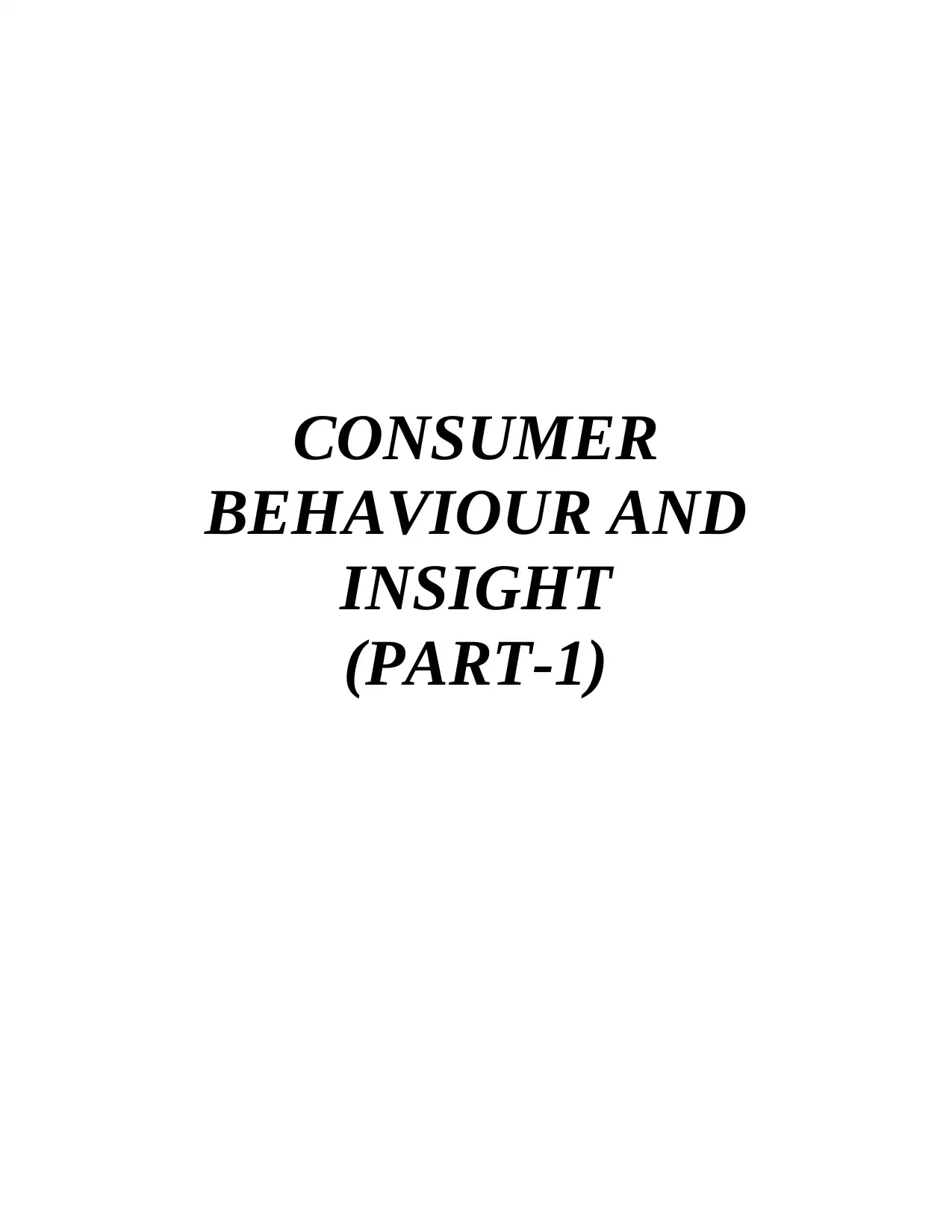
CONSUMER
BEHAVIOUR AND
INSIGHT
(PART-1)
BEHAVIOUR AND
INSIGHT
(PART-1)
Paraphrase This Document
Need a fresh take? Get an instant paraphrase of this document with our AI Paraphraser
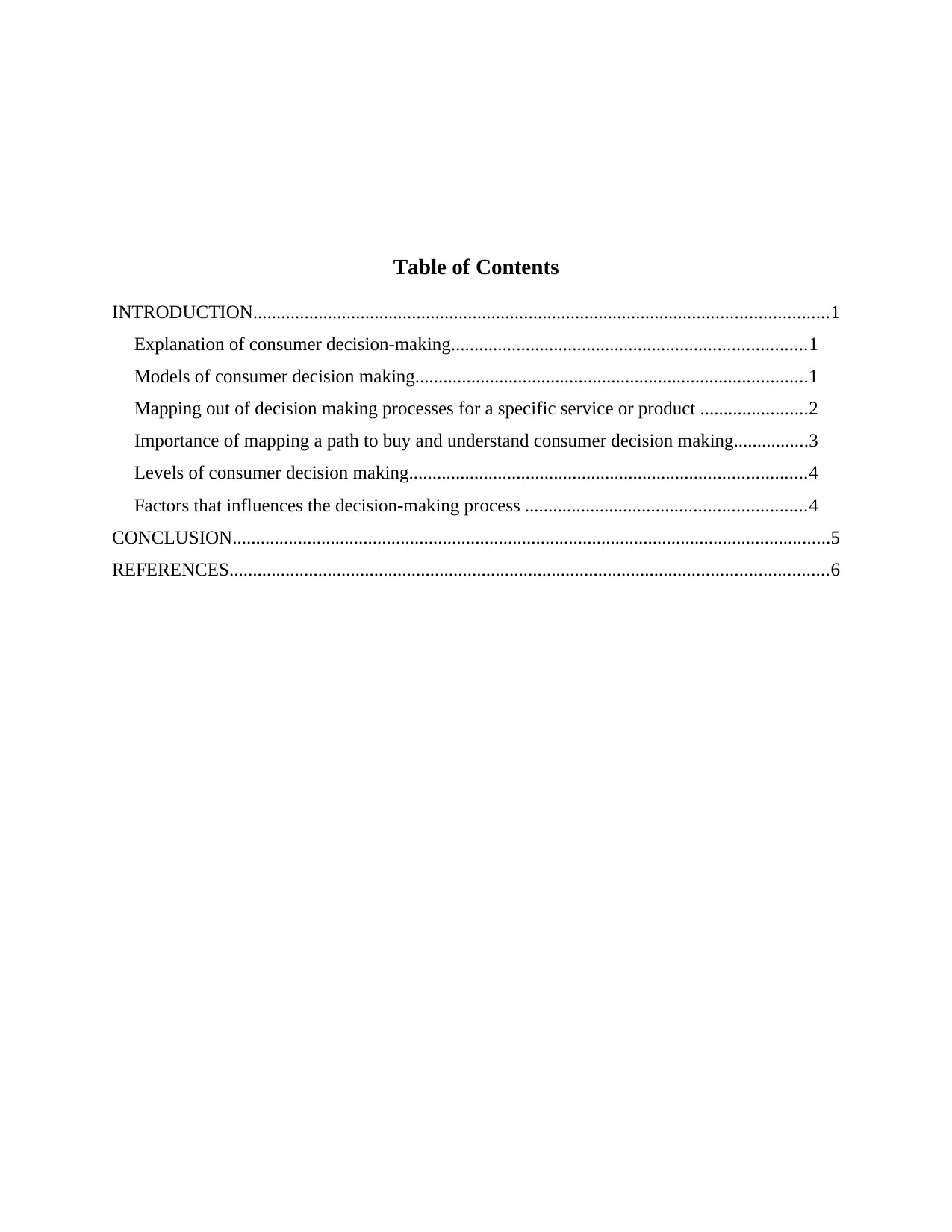
Table of Contents
INTRODUCTION...........................................................................................................................1
Explanation of consumer decision-making............................................................................1
Models of consumer decision making....................................................................................1
Mapping out of decision making processes for a specific service or product .......................2
Importance of mapping a path to buy and understand consumer decision making................3
Levels of consumer decision making.....................................................................................4
Factors that influences the decision-making process ............................................................4
CONCLUSION................................................................................................................................5
REFERENCES................................................................................................................................6
INTRODUCTION...........................................................................................................................1
Explanation of consumer decision-making............................................................................1
Models of consumer decision making....................................................................................1
Mapping out of decision making processes for a specific service or product .......................2
Importance of mapping a path to buy and understand consumer decision making................3
Levels of consumer decision making.....................................................................................4
Factors that influences the decision-making process ............................................................4
CONCLUSION................................................................................................................................5
REFERENCES................................................................................................................................6
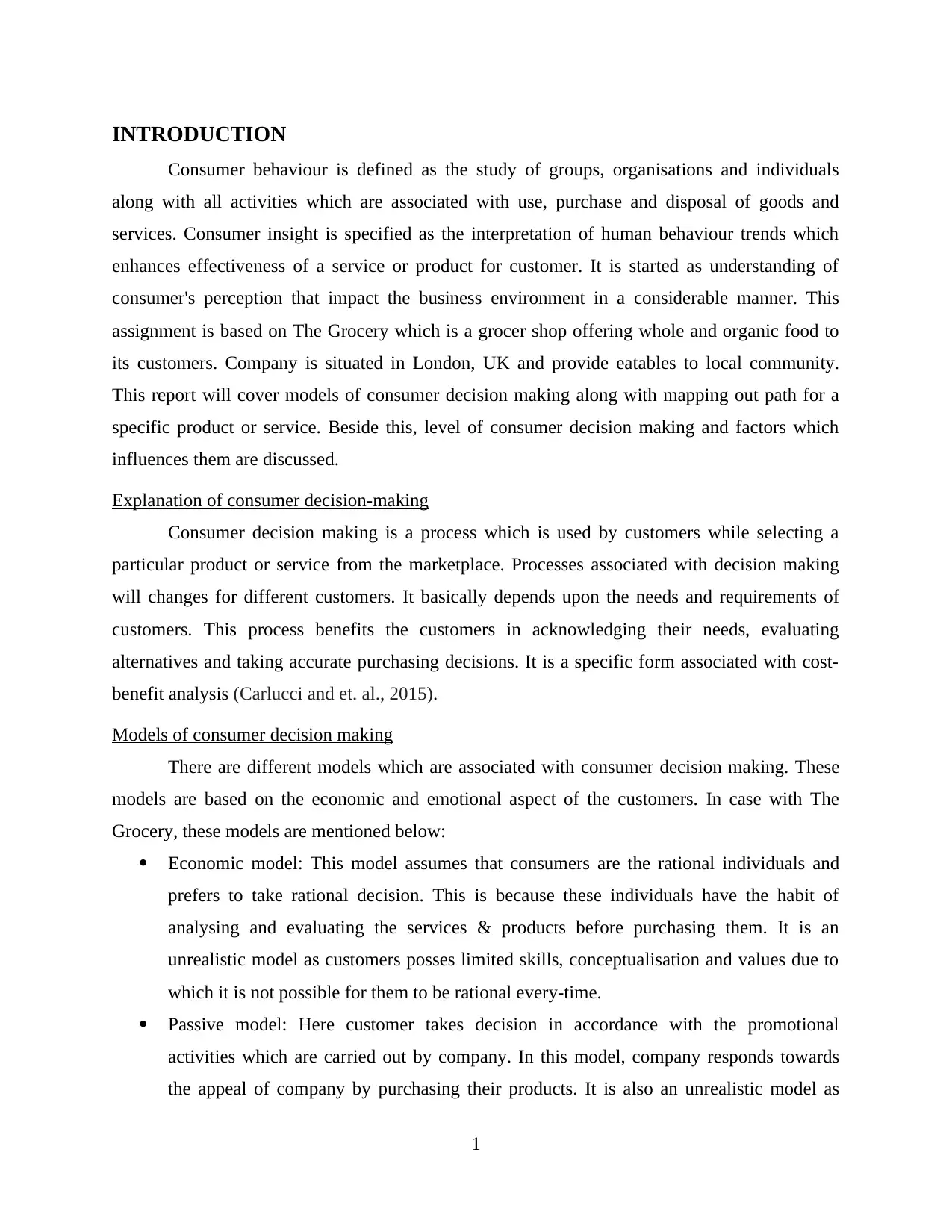
INTRODUCTION
Consumer behaviour is defined as the study of groups, organisations and individuals
along with all activities which are associated with use, purchase and disposal of goods and
services. Consumer insight is specified as the interpretation of human behaviour trends which
enhances effectiveness of a service or product for customer. It is started as understanding of
consumer's perception that impact the business environment in a considerable manner. This
assignment is based on The Grocery which is a grocer shop offering whole and organic food to
its customers. Company is situated in London, UK and provide eatables to local community.
This report will cover models of consumer decision making along with mapping out path for a
specific product or service. Beside this, level of consumer decision making and factors which
influences them are discussed.
Explanation of consumer decision-making
Consumer decision making is a process which is used by customers while selecting a
particular product or service from the marketplace. Processes associated with decision making
will changes for different customers. It basically depends upon the needs and requirements of
customers. This process benefits the customers in acknowledging their needs, evaluating
alternatives and taking accurate purchasing decisions. It is a specific form associated with cost-
benefit analysis (Carlucci and et. al., 2015).
Models of consumer decision making
There are different models which are associated with consumer decision making. These
models are based on the economic and emotional aspect of the customers. In case with The
Grocery, these models are mentioned below:
Economic model: This model assumes that consumers are the rational individuals and
prefers to take rational decision. This is because these individuals have the habit of
analysing and evaluating the services & products before purchasing them. It is an
unrealistic model as customers posses limited skills, conceptualisation and values due to
which it is not possible for them to be rational every-time.
Passive model: Here customer takes decision in accordance with the promotional
activities which are carried out by company. In this model, company responds towards
the appeal of company by purchasing their products. It is also an unrealistic model as
1
Consumer behaviour is defined as the study of groups, organisations and individuals
along with all activities which are associated with use, purchase and disposal of goods and
services. Consumer insight is specified as the interpretation of human behaviour trends which
enhances effectiveness of a service or product for customer. It is started as understanding of
consumer's perception that impact the business environment in a considerable manner. This
assignment is based on The Grocery which is a grocer shop offering whole and organic food to
its customers. Company is situated in London, UK and provide eatables to local community.
This report will cover models of consumer decision making along with mapping out path for a
specific product or service. Beside this, level of consumer decision making and factors which
influences them are discussed.
Explanation of consumer decision-making
Consumer decision making is a process which is used by customers while selecting a
particular product or service from the marketplace. Processes associated with decision making
will changes for different customers. It basically depends upon the needs and requirements of
customers. This process benefits the customers in acknowledging their needs, evaluating
alternatives and taking accurate purchasing decisions. It is a specific form associated with cost-
benefit analysis (Carlucci and et. al., 2015).
Models of consumer decision making
There are different models which are associated with consumer decision making. These
models are based on the economic and emotional aspect of the customers. In case with The
Grocery, these models are mentioned below:
Economic model: This model assumes that consumers are the rational individuals and
prefers to take rational decision. This is because these individuals have the habit of
analysing and evaluating the services & products before purchasing them. It is an
unrealistic model as customers posses limited skills, conceptualisation and values due to
which it is not possible for them to be rational every-time.
Passive model: Here customer takes decision in accordance with the promotional
activities which are carried out by company. In this model, company responds towards
the appeal of company by purchasing their products. It is also an unrealistic model as
1
⊘ This is a preview!⊘
Do you want full access?
Subscribe today to unlock all pages.

Trusted by 1+ million students worldwide
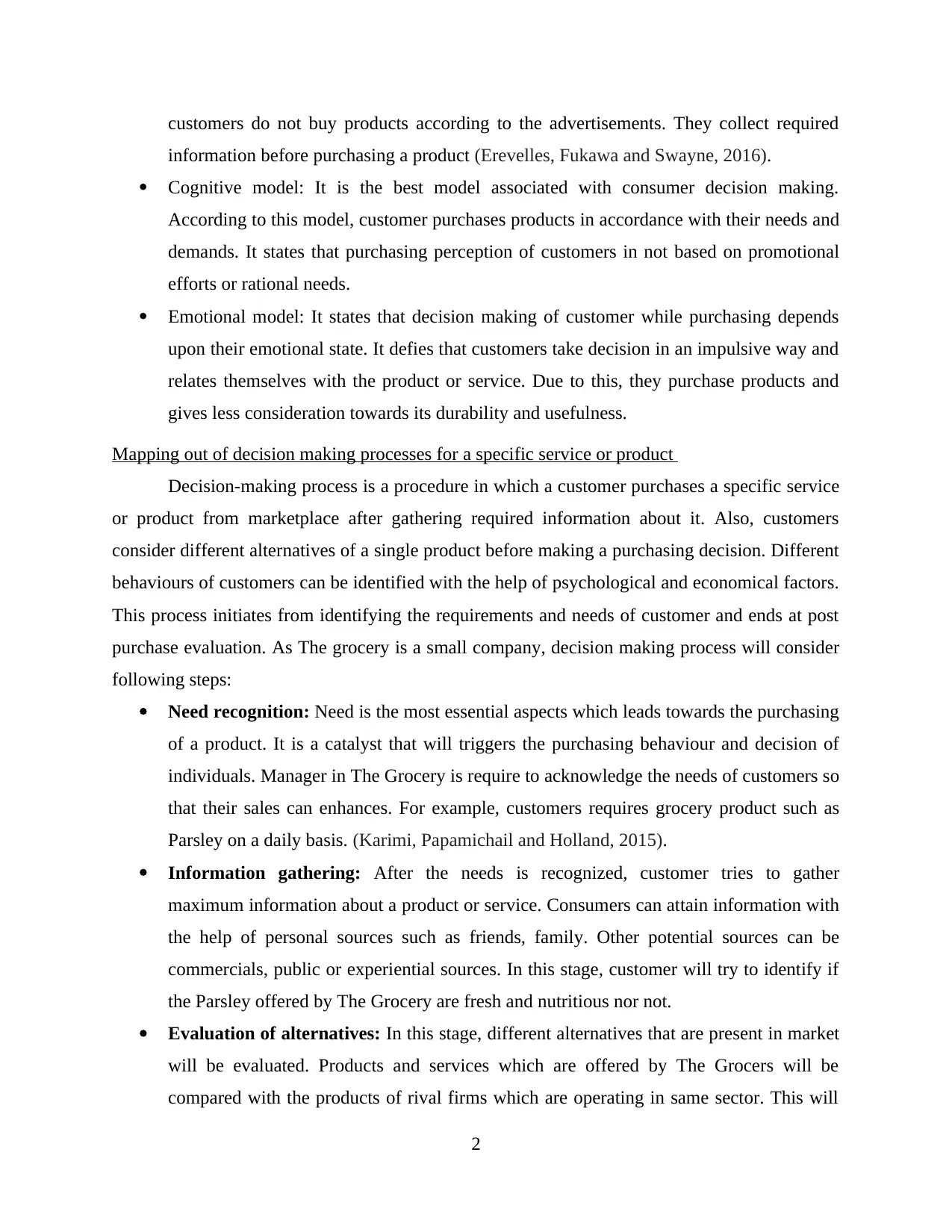
customers do not buy products according to the advertisements. They collect required
information before purchasing a product (Erevelles, Fukawa and Swayne, 2016).
Cognitive model: It is the best model associated with consumer decision making.
According to this model, customer purchases products in accordance with their needs and
demands. It states that purchasing perception of customers in not based on promotional
efforts or rational needs.
Emotional model: It states that decision making of customer while purchasing depends
upon their emotional state. It defies that customers take decision in an impulsive way and
relates themselves with the product or service. Due to this, they purchase products and
gives less consideration towards its durability and usefulness.
Mapping out of decision making processes for a specific service or product
Decision-making process is a procedure in which a customer purchases a specific service
or product from marketplace after gathering required information about it. Also, customers
consider different alternatives of a single product before making a purchasing decision. Different
behaviours of customers can be identified with the help of psychological and economical factors.
This process initiates from identifying the requirements and needs of customer and ends at post
purchase evaluation. As The grocery is a small company, decision making process will consider
following steps:
Need recognition: Need is the most essential aspects which leads towards the purchasing
of a product. It is a catalyst that will triggers the purchasing behaviour and decision of
individuals. Manager in The Grocery is require to acknowledge the needs of customers so
that their sales can enhances. For example, customers requires grocery product such as
Parsley on a daily basis. (Karimi, Papamichail and Holland, 2015).
Information gathering: After the needs is recognized, customer tries to gather
maximum information about a product or service. Consumers can attain information with
the help of personal sources such as friends, family. Other potential sources can be
commercials, public or experiential sources. In this stage, customer will try to identify if
the Parsley offered by The Grocery are fresh and nutritious nor not.
Evaluation of alternatives: In this stage, different alternatives that are present in market
will be evaluated. Products and services which are offered by The Grocers will be
compared with the products of rival firms which are operating in same sector. This will
2
information before purchasing a product (Erevelles, Fukawa and Swayne, 2016).
Cognitive model: It is the best model associated with consumer decision making.
According to this model, customer purchases products in accordance with their needs and
demands. It states that purchasing perception of customers in not based on promotional
efforts or rational needs.
Emotional model: It states that decision making of customer while purchasing depends
upon their emotional state. It defies that customers take decision in an impulsive way and
relates themselves with the product or service. Due to this, they purchase products and
gives less consideration towards its durability and usefulness.
Mapping out of decision making processes for a specific service or product
Decision-making process is a procedure in which a customer purchases a specific service
or product from marketplace after gathering required information about it. Also, customers
consider different alternatives of a single product before making a purchasing decision. Different
behaviours of customers can be identified with the help of psychological and economical factors.
This process initiates from identifying the requirements and needs of customer and ends at post
purchase evaluation. As The grocery is a small company, decision making process will consider
following steps:
Need recognition: Need is the most essential aspects which leads towards the purchasing
of a product. It is a catalyst that will triggers the purchasing behaviour and decision of
individuals. Manager in The Grocery is require to acknowledge the needs of customers so
that their sales can enhances. For example, customers requires grocery product such as
Parsley on a daily basis. (Karimi, Papamichail and Holland, 2015).
Information gathering: After the needs is recognized, customer tries to gather
maximum information about a product or service. Consumers can attain information with
the help of personal sources such as friends, family. Other potential sources can be
commercials, public or experiential sources. In this stage, customer will try to identify if
the Parsley offered by The Grocery are fresh and nutritious nor not.
Evaluation of alternatives: In this stage, different alternatives that are present in market
will be evaluated. Products and services which are offered by The Grocers will be
compared with the products of rival firms which are operating in same sector. This will
2
Paraphrase This Document
Need a fresh take? Get an instant paraphrase of this document with our AI Paraphraser
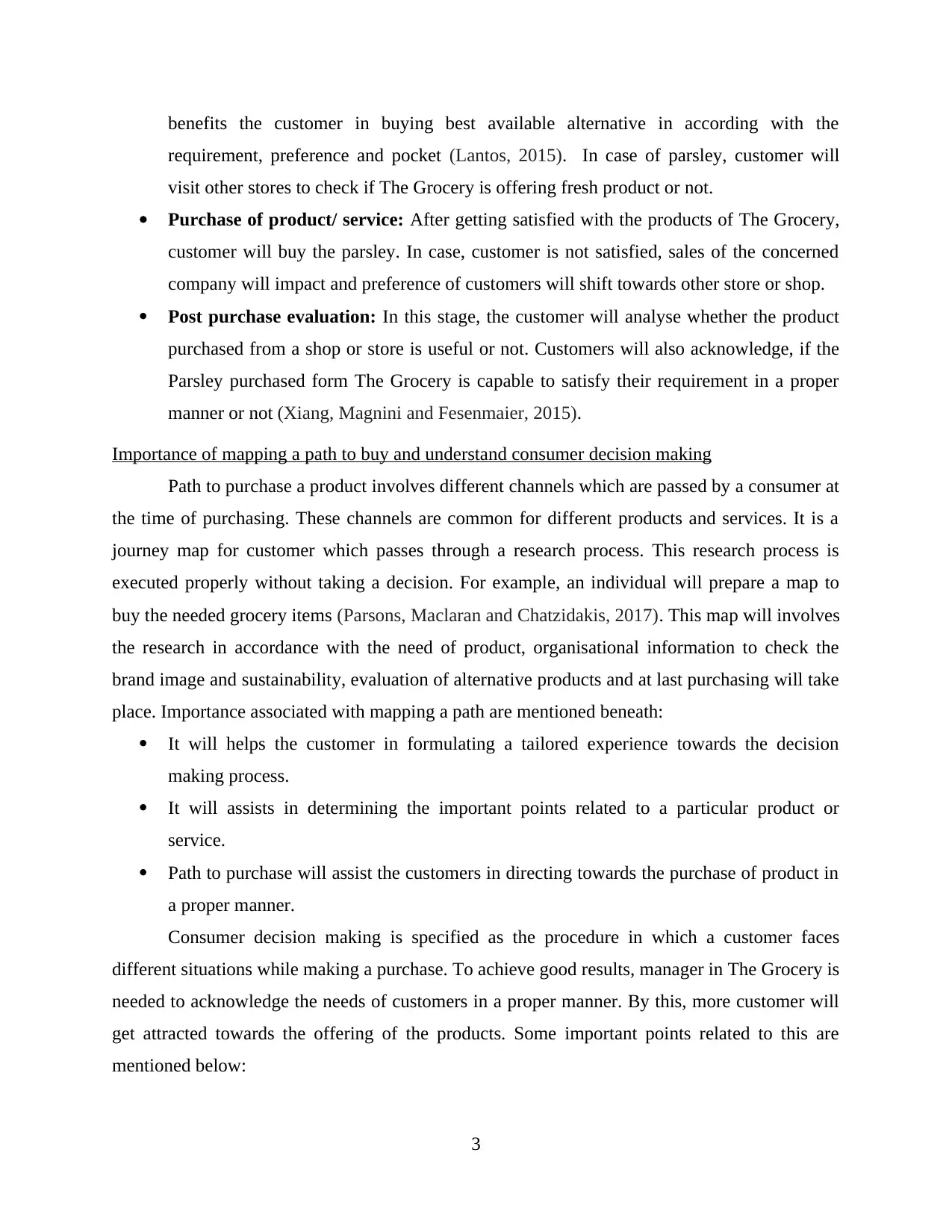
benefits the customer in buying best available alternative in according with the
requirement, preference and pocket (Lantos, 2015). In case of parsley, customer will
visit other stores to check if The Grocery is offering fresh product or not.
Purchase of product/ service: After getting satisfied with the products of The Grocery,
customer will buy the parsley. In case, customer is not satisfied, sales of the concerned
company will impact and preference of customers will shift towards other store or shop.
Post purchase evaluation: In this stage, the customer will analyse whether the product
purchased from a shop or store is useful or not. Customers will also acknowledge, if the
Parsley purchased form The Grocery is capable to satisfy their requirement in a proper
manner or not (Xiang, Magnini and Fesenmaier, 2015).
Importance of mapping a path to buy and understand consumer decision making
Path to purchase a product involves different channels which are passed by a consumer at
the time of purchasing. These channels are common for different products and services. It is a
journey map for customer which passes through a research process. This research process is
executed properly without taking a decision. For example, an individual will prepare a map to
buy the needed grocery items (Parsons, Maclaran and Chatzidakis, 2017). This map will involves
the research in accordance with the need of product, organisational information to check the
brand image and sustainability, evaluation of alternative products and at last purchasing will take
place. Importance associated with mapping a path are mentioned beneath:
It will helps the customer in formulating a tailored experience towards the decision
making process.
It will assists in determining the important points related to a particular product or
service.
Path to purchase will assist the customers in directing towards the purchase of product in
a proper manner.
Consumer decision making is specified as the procedure in which a customer faces
different situations while making a purchase. To achieve good results, manager in The Grocery is
needed to acknowledge the needs of customers in a proper manner. By this, more customer will
get attracted towards the offering of the products. Some important points related to this are
mentioned below:
3
requirement, preference and pocket (Lantos, 2015). In case of parsley, customer will
visit other stores to check if The Grocery is offering fresh product or not.
Purchase of product/ service: After getting satisfied with the products of The Grocery,
customer will buy the parsley. In case, customer is not satisfied, sales of the concerned
company will impact and preference of customers will shift towards other store or shop.
Post purchase evaluation: In this stage, the customer will analyse whether the product
purchased from a shop or store is useful or not. Customers will also acknowledge, if the
Parsley purchased form The Grocery is capable to satisfy their requirement in a proper
manner or not (Xiang, Magnini and Fesenmaier, 2015).
Importance of mapping a path to buy and understand consumer decision making
Path to purchase a product involves different channels which are passed by a consumer at
the time of purchasing. These channels are common for different products and services. It is a
journey map for customer which passes through a research process. This research process is
executed properly without taking a decision. For example, an individual will prepare a map to
buy the needed grocery items (Parsons, Maclaran and Chatzidakis, 2017). This map will involves
the research in accordance with the need of product, organisational information to check the
brand image and sustainability, evaluation of alternative products and at last purchasing will take
place. Importance associated with mapping a path are mentioned beneath:
It will helps the customer in formulating a tailored experience towards the decision
making process.
It will assists in determining the important points related to a particular product or
service.
Path to purchase will assist the customers in directing towards the purchase of product in
a proper manner.
Consumer decision making is specified as the procedure in which a customer faces
different situations while making a purchase. To achieve good results, manager in The Grocery is
needed to acknowledge the needs of customers in a proper manner. By this, more customer will
get attracted towards the offering of the products. Some important points related to this are
mentioned below:
3
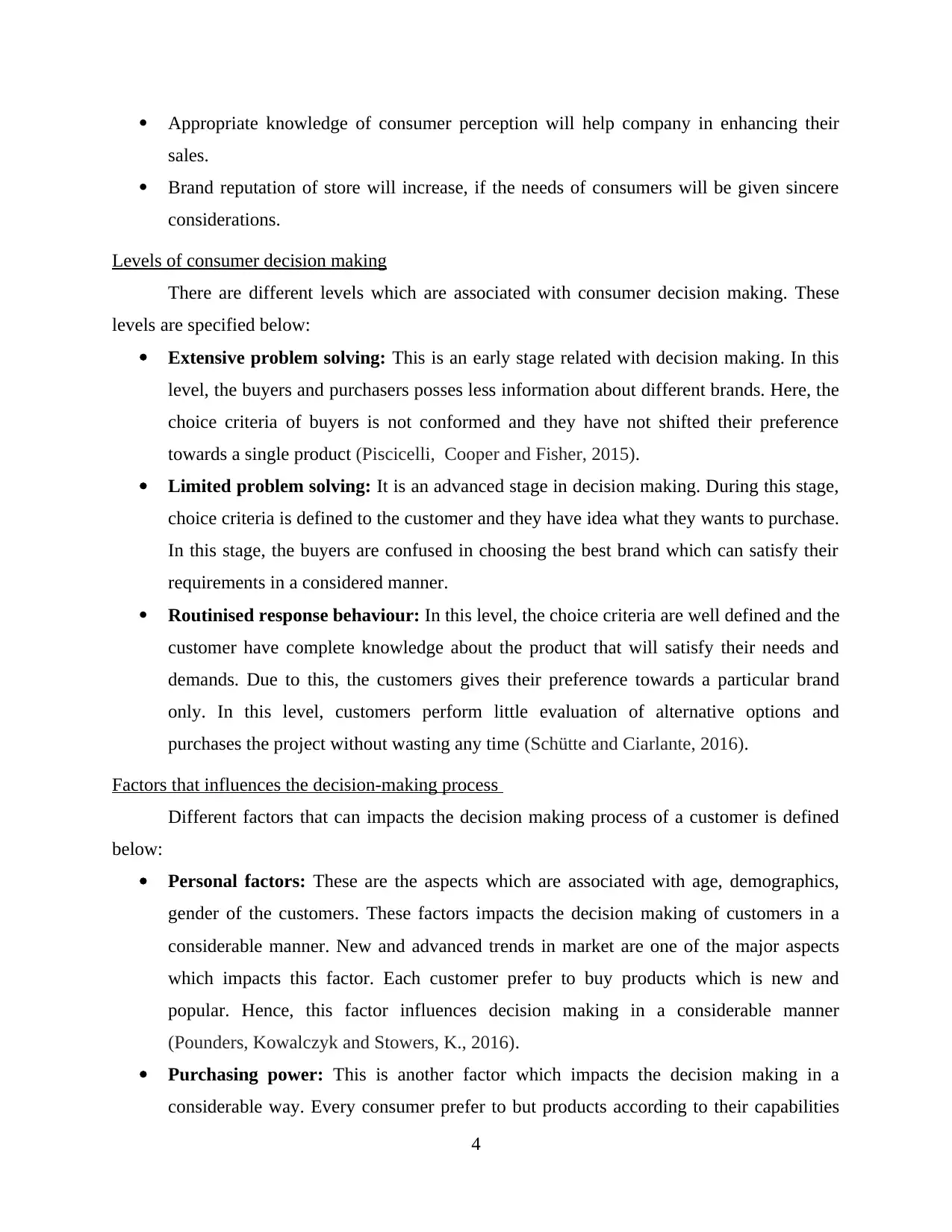
Appropriate knowledge of consumer perception will help company in enhancing their
sales.
Brand reputation of store will increase, if the needs of consumers will be given sincere
considerations.
Levels of consumer decision making
There are different levels which are associated with consumer decision making. These
levels are specified below:
Extensive problem solving: This is an early stage related with decision making. In this
level, the buyers and purchasers posses less information about different brands. Here, the
choice criteria of buyers is not conformed and they have not shifted their preference
towards a single product (Piscicelli, Cooper and Fisher, 2015).
Limited problem solving: It is an advanced stage in decision making. During this stage,
choice criteria is defined to the customer and they have idea what they wants to purchase.
In this stage, the buyers are confused in choosing the best brand which can satisfy their
requirements in a considered manner.
Routinised response behaviour: In this level, the choice criteria are well defined and the
customer have complete knowledge about the product that will satisfy their needs and
demands. Due to this, the customers gives their preference towards a particular brand
only. In this level, customers perform little evaluation of alternative options and
purchases the project without wasting any time (Schütte and Ciarlante, 2016).
Factors that influences the decision-making process
Different factors that can impacts the decision making process of a customer is defined
below:
Personal factors: These are the aspects which are associated with age, demographics,
gender of the customers. These factors impacts the decision making of customers in a
considerable manner. New and advanced trends in market are one of the major aspects
which impacts this factor. Each customer prefer to buy products which is new and
popular. Hence, this factor influences decision making in a considerable manner
(Pounders, Kowalczyk and Stowers, K., 2016).
Purchasing power: This is another factor which impacts the decision making in a
considerable way. Every consumer prefer to but products according to their capabilities
4
sales.
Brand reputation of store will increase, if the needs of consumers will be given sincere
considerations.
Levels of consumer decision making
There are different levels which are associated with consumer decision making. These
levels are specified below:
Extensive problem solving: This is an early stage related with decision making. In this
level, the buyers and purchasers posses less information about different brands. Here, the
choice criteria of buyers is not conformed and they have not shifted their preference
towards a single product (Piscicelli, Cooper and Fisher, 2015).
Limited problem solving: It is an advanced stage in decision making. During this stage,
choice criteria is defined to the customer and they have idea what they wants to purchase.
In this stage, the buyers are confused in choosing the best brand which can satisfy their
requirements in a considered manner.
Routinised response behaviour: In this level, the choice criteria are well defined and the
customer have complete knowledge about the product that will satisfy their needs and
demands. Due to this, the customers gives their preference towards a particular brand
only. In this level, customers perform little evaluation of alternative options and
purchases the project without wasting any time (Schütte and Ciarlante, 2016).
Factors that influences the decision-making process
Different factors that can impacts the decision making process of a customer is defined
below:
Personal factors: These are the aspects which are associated with age, demographics,
gender of the customers. These factors impacts the decision making of customers in a
considerable manner. New and advanced trends in market are one of the major aspects
which impacts this factor. Each customer prefer to buy products which is new and
popular. Hence, this factor influences decision making in a considerable manner
(Pounders, Kowalczyk and Stowers, K., 2016).
Purchasing power: This is another factor which impacts the decision making in a
considerable way. Every consumer prefer to but products according to their capabilities
4
⊘ This is a preview!⊘
Do you want full access?
Subscribe today to unlock all pages.

Trusted by 1+ million students worldwide
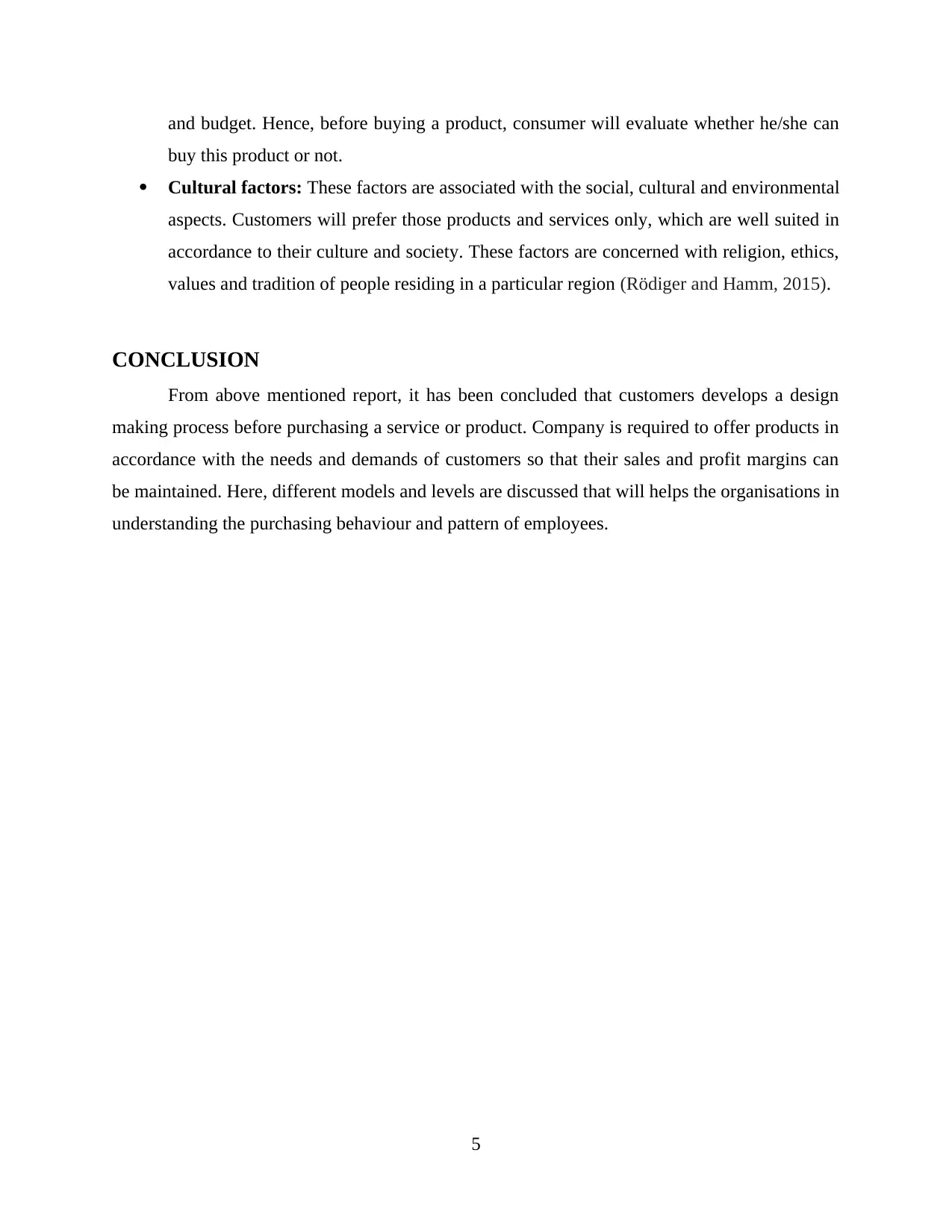
and budget. Hence, before buying a product, consumer will evaluate whether he/she can
buy this product or not.
Cultural factors: These factors are associated with the social, cultural and environmental
aspects. Customers will prefer those products and services only, which are well suited in
accordance to their culture and society. These factors are concerned with religion, ethics,
values and tradition of people residing in a particular region (Rödiger and Hamm, 2015).
CONCLUSION
From above mentioned report, it has been concluded that customers develops a design
making process before purchasing a service or product. Company is required to offer products in
accordance with the needs and demands of customers so that their sales and profit margins can
be maintained. Here, different models and levels are discussed that will helps the organisations in
understanding the purchasing behaviour and pattern of employees.
5
buy this product or not.
Cultural factors: These factors are associated with the social, cultural and environmental
aspects. Customers will prefer those products and services only, which are well suited in
accordance to their culture and society. These factors are concerned with religion, ethics,
values and tradition of people residing in a particular region (Rödiger and Hamm, 2015).
CONCLUSION
From above mentioned report, it has been concluded that customers develops a design
making process before purchasing a service or product. Company is required to offer products in
accordance with the needs and demands of customers so that their sales and profit margins can
be maintained. Here, different models and levels are discussed that will helps the organisations in
understanding the purchasing behaviour and pattern of employees.
5
Paraphrase This Document
Need a fresh take? Get an instant paraphrase of this document with our AI Paraphraser
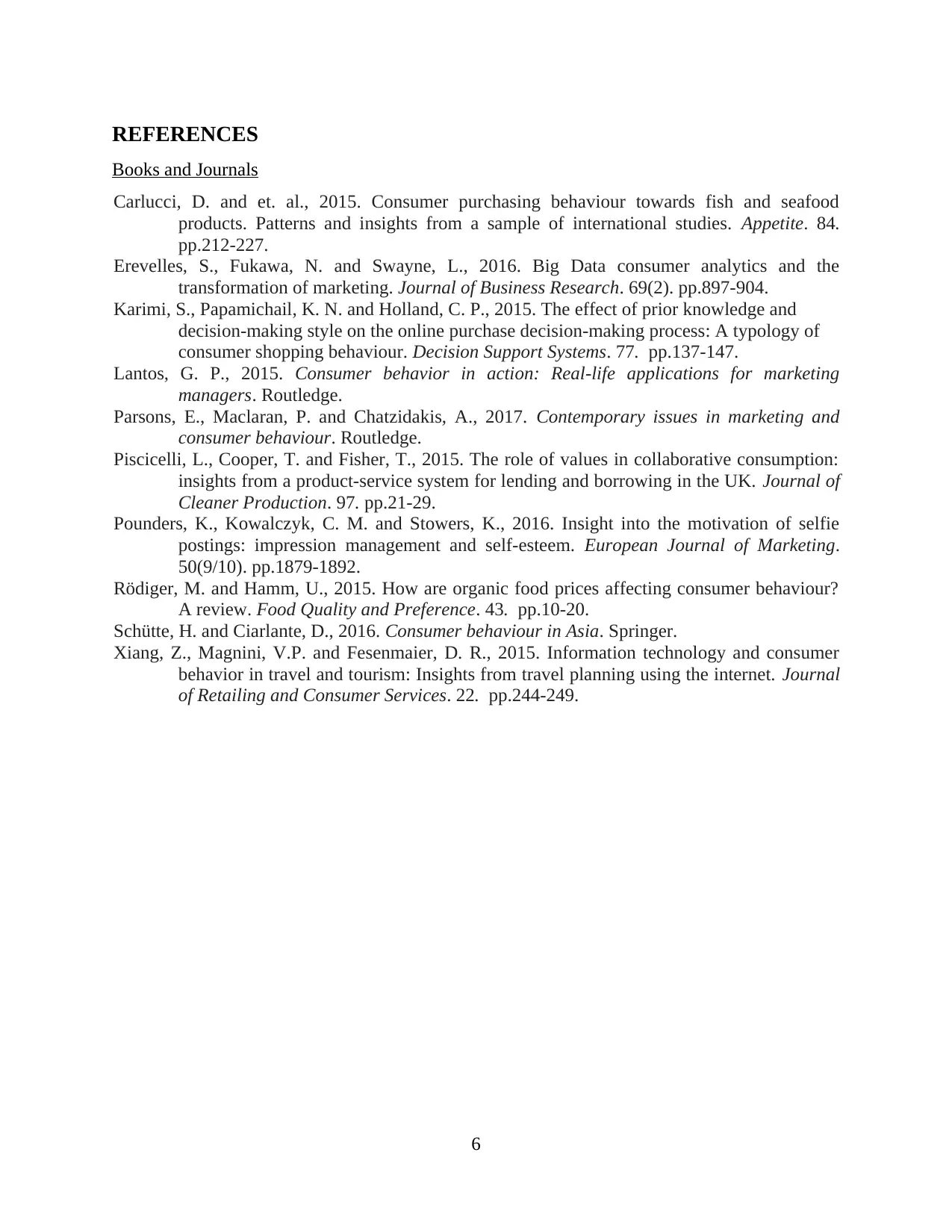
REFERENCES
Books and Journals
Carlucci, D. and et. al., 2015. Consumer purchasing behaviour towards fish and seafood
products. Patterns and insights from a sample of international studies. Appetite. 84.
pp.212-227.
Erevelles, S., Fukawa, N. and Swayne, L., 2016. Big Data consumer analytics and the
transformation of marketing. Journal of Business Research. 69(2). pp.897-904.
Karimi, S., Papamichail, K. N. and Holland, C. P., 2015. The effect of prior knowledge and
decision-making style on the online purchase decision-making process: A typology of
consumer shopping behaviour. Decision Support Systems. 77. pp.137-147.
Lantos, G. P., 2015. Consumer behavior in action: Real-life applications for marketing
managers. Routledge.
Parsons, E., Maclaran, P. and Chatzidakis, A., 2017. Contemporary issues in marketing and
consumer behaviour. Routledge.
Piscicelli, L., Cooper, T. and Fisher, T., 2015. The role of values in collaborative consumption:
insights from a product-service system for lending and borrowing in the UK. Journal of
Cleaner Production. 97. pp.21-29.
Pounders, K., Kowalczyk, C. M. and Stowers, K., 2016. Insight into the motivation of selfie
postings: impression management and self-esteem. European Journal of Marketing.
50(9/10). pp.1879-1892.
Rödiger, M. and Hamm, U., 2015. How are organic food prices affecting consumer behaviour?
A review. Food Quality and Preference. 43. pp.10-20.
Schütte, H. and Ciarlante, D., 2016. Consumer behaviour in Asia. Springer.
Xiang, Z., Magnini, V.P. and Fesenmaier, D. R., 2015. Information technology and consumer
behavior in travel and tourism: Insights from travel planning using the internet. Journal
of Retailing and Consumer Services. 22. pp.244-249.
6
Books and Journals
Carlucci, D. and et. al., 2015. Consumer purchasing behaviour towards fish and seafood
products. Patterns and insights from a sample of international studies. Appetite. 84.
pp.212-227.
Erevelles, S., Fukawa, N. and Swayne, L., 2016. Big Data consumer analytics and the
transformation of marketing. Journal of Business Research. 69(2). pp.897-904.
Karimi, S., Papamichail, K. N. and Holland, C. P., 2015. The effect of prior knowledge and
decision-making style on the online purchase decision-making process: A typology of
consumer shopping behaviour. Decision Support Systems. 77. pp.137-147.
Lantos, G. P., 2015. Consumer behavior in action: Real-life applications for marketing
managers. Routledge.
Parsons, E., Maclaran, P. and Chatzidakis, A., 2017. Contemporary issues in marketing and
consumer behaviour. Routledge.
Piscicelli, L., Cooper, T. and Fisher, T., 2015. The role of values in collaborative consumption:
insights from a product-service system for lending and borrowing in the UK. Journal of
Cleaner Production. 97. pp.21-29.
Pounders, K., Kowalczyk, C. M. and Stowers, K., 2016. Insight into the motivation of selfie
postings: impression management and self-esteem. European Journal of Marketing.
50(9/10). pp.1879-1892.
Rödiger, M. and Hamm, U., 2015. How are organic food prices affecting consumer behaviour?
A review. Food Quality and Preference. 43. pp.10-20.
Schütte, H. and Ciarlante, D., 2016. Consumer behaviour in Asia. Springer.
Xiang, Z., Magnini, V.P. and Fesenmaier, D. R., 2015. Information technology and consumer
behavior in travel and tourism: Insights from travel planning using the internet. Journal
of Retailing and Consumer Services. 22. pp.244-249.
6
1 out of 8
Related Documents
Your All-in-One AI-Powered Toolkit for Academic Success.
+13062052269
info@desklib.com
Available 24*7 on WhatsApp / Email
![[object Object]](/_next/static/media/star-bottom.7253800d.svg)
Unlock your academic potential
Copyright © 2020–2025 A2Z Services. All Rights Reserved. Developed and managed by ZUCOL.





